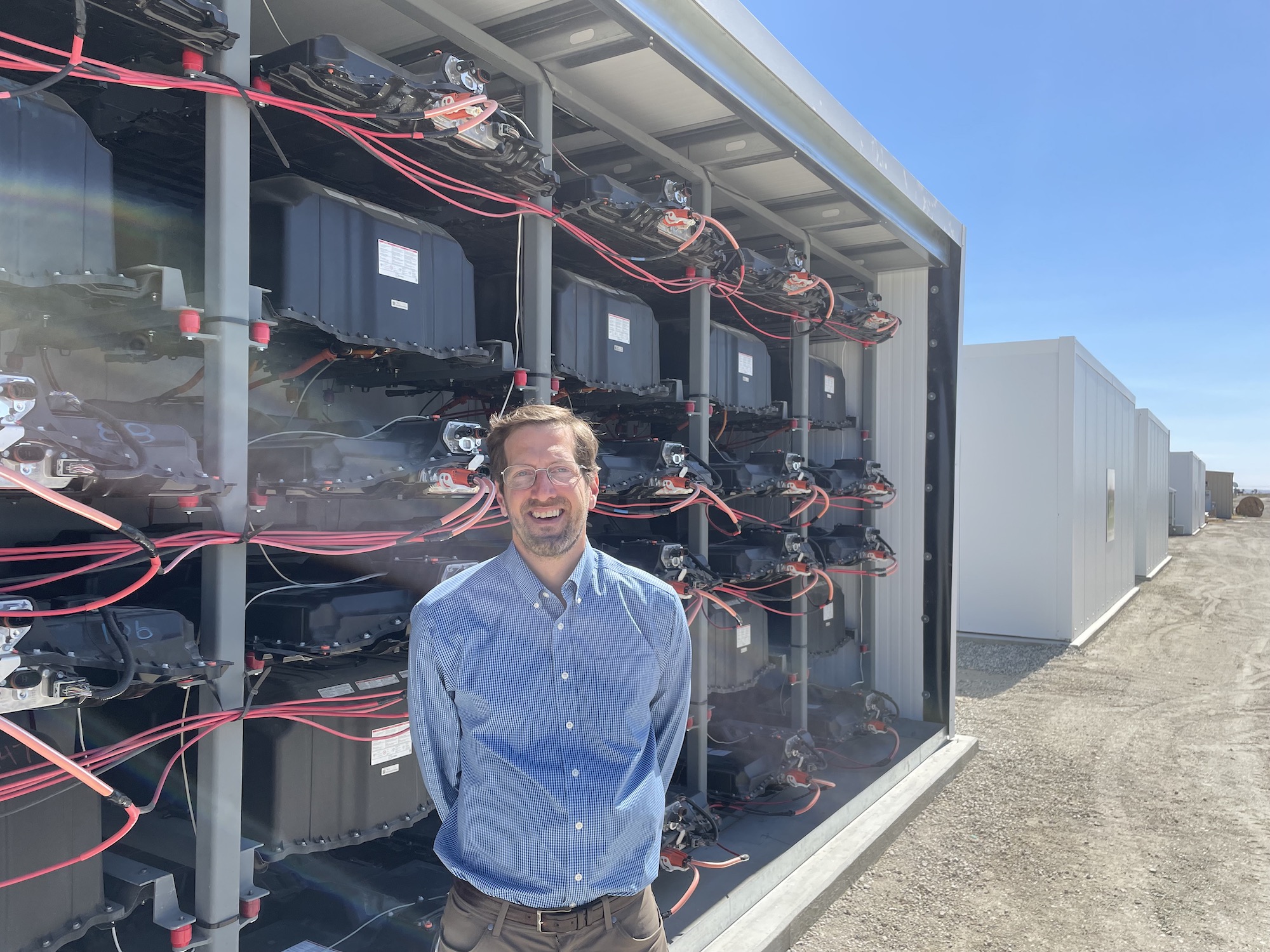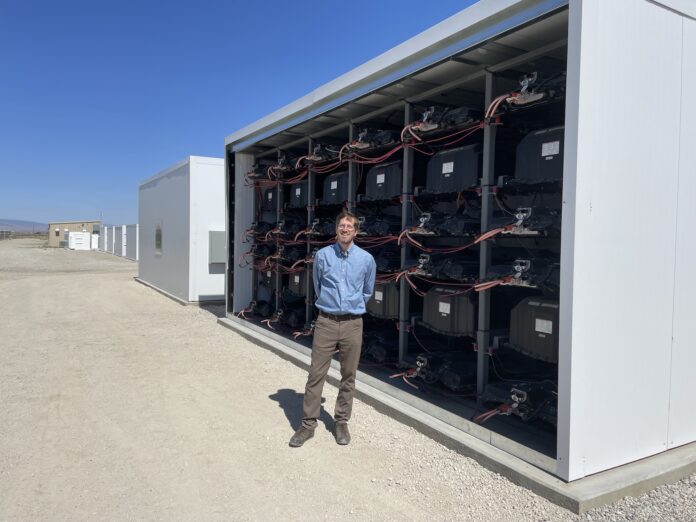Next to a solar array in Lancaster, a pilot project is under way that could hold a key to solving one of the state’s most vexing energy problems.
As the state transitions its power supply to solar, wind and other renewable sources, the most daunting challenge has been to secure enough capacity to store the energy when it’s generated to be used later when it’s in most demand. Anything that can store energy is being looked at, from giant battery cells and flywheels to pumped water and thermal energy conveyance systems.
But one local company, B2U Storage Solutions Inc., has turned to an unexpected – and rapidly growing – storage source: electric vehicle batteries. The Sawtelle-based company has developed technology that can integrate thousands of used EV batteries into arrays that can store megawatts of electricity from wind, solar and other renewable sources – essentially giving these EV batteries an extension of life before they are ultimately recycled to extract their component parts.
B2U Storage Solutions is now proving its technology at a facility in Lancaster, where it has assembled about 1,300 used EV batteries it has bought or leased from Honda Motor Co. and Nissan Motor Co.
The battery assemblies, which are housed in cabinets next to a solar array, are cumulatively capable of storing up to 25 megawatts of electricity that can be placed onto the grid at times of peak demand – enough electricity to power as many as 10,000 homes.
B2U has been gradually ramping up capacity at the Lancaster site it calls “Sierra” since 2020, putting whatever power it stores onto the state’s wholesale electricity market at times of elevated demand. The company earned $1 million from these wholesale transactions last year.
“You can get a lot of value in EV battery second life, if you find the right use,” said Freeman Hall, B2U’s chief executive. “With our technology, we can deploy a lot of EV batteries and wire them together in large-scale projects.”
Solar power roots
Hall has spent nearly two decades consulting on or developing large-scale renewable power projects – mostly focused on solar power. In 2008 he teamed up with a solar systems engineer, Michael Stern, to found a large-scale solar project development company called Solar Electric Solutions.
Over the next decade, that company brought roughly 1,100 megawatts of solar power generation online in Southern California. But by 2018, with solar power-generation costs rapidly falling and the number of projects deployed multiplying throughout the state, Hall and Stern realized the next big opportunity was going to be in energy storage to offset the gaps in power supplies when solar and wind plants are offline.
“That’s when we decided to shift gears and get into large-scale battery storage,” Hall said. “We realized traditional large battery cells were very expensive. But we knew of science experiments and small-scale projects that were using EV batteries. And we knew, that, thanks to electric vehicle mandates, more and more EV batteries would be coming onto the market.”
So in 2018 the pair pivoted their business, reincorporating their company under a new name, B2U Storage Solutions; B2U stands for “battery second use.”
The central concept underlying this transition is the realization that electricity storage doesn’t require as much current as a battery deployed in an electric vehicle having to run all of that vehicle’s component parts. That means even when there’s not enough battery capacity to run a vehicle, there may still be enough to store electricity.
Also, Hall said, “When you convert an EV battery for use in storing electricity, there’s much less resistance, and therefore the battery can last longer.”
But the key challenge was to string together enough used EV batteries to make a significant difference. That’s where previous startups in this nascent market had run into difficulties, according to Alissa Kendall, professor of civil and environmental engineering and chair of the energy graduate group at UC Davis.
“A lot of people had thought that if you reuse these batteries, you have to take apart the battery and take out the bad modules or cells and put in new modules or cells, essentially creating a new battery out of one or more used batteries,” Kendall said. “That requires a lot of hours and highly trained labor, making it very costly.”
B2U took a different approach. It decided to create battery arrays in which the individual batteries remained largely intact.
The company also had to tackle another issue: Each EV battery has software that enables it to communicate with the electronic systems in the vehicle it’s intended for. But batteries from different EV models weren’t designed to be interchangeable, making it harder for them to work in unison.
Hall said the company has spent the last five years developing and honing technology to synchronize communications between used EV batteries.
Taken together, these are the key innovations that Kendall said has essentially made B2U a “first mover” in this field of repurposing used EV batteries as stationary power-storage devices.
In 2021, B2U Storage Solutions raised $10 million in Series A financing to continue developing the technology and begin in earnest deploying the batteries at its Lancaster site.
Battery collection challenges

Meanwhile, the company also had to figure out ways to source used electric vehicle batteries, with hundreds at a time coming from the same original (auto) equipment manufacturer.
Up until about five years ago, electric vehicles were not produced in anywhere near the quanities they are today. So the number of EV batteries at the end of their 10-year warranties is still relatively small. Also, most original equipment manufacturers have sent their used EV batteries directly to recyclers and have not until very recently considered second-life uses as a viable option.
But B2U has convinced some automakers. Take Honda, which has leased several hundred used EV batteries to B2U.
Bradley Smith, manager of battery value chain business development and sustainability business development for the car company, said Honda learned of B2U through its reuse and recycling development activities.
“We’re always looking at ways to maximize the value of the most valuable components of a battery electric vehicle,” Smith said. “After it’s no longer ideal for mobility, we will work to establish second and third uses, and one example is stationary energy storage as a potentially meaningful step in the overall EV battery lifecycle management process.”
Smith indicated Honda intends to keep working with B2U for the foreseeable future.
Power demand
On the other side of the equation – the electric power suppliers – the renewable-sourced power that B2U has placed onto the grid at peak demand times has been welcomed.
Downtown-based Clean Power Alliance of Southern California, for example, had been looking for ways to meet state requirements to have enough power on hand when the state’s grid operator, known as the California Independent System Operator, or CAISO, calls for it at times of high demand and crunched power supplies.
The Clean Power Alliance was launched in 2018 as a public power authority; it now has 35 member cities and jurisdictions and serves roughly 1 million customer accounts in large swaths of Los Angeles and Ventura counties. The alliance has a mission to derive as much power as possible from renewable resources and B2U fit that bill, according to Ted Bardacke, the alliance’s chief executive.
“B2U’s business model of used EV batteries is a really interesting development in the industry,” Bardacke said. “As long as they are able to meet contract obligations at a reasonable price, there should be a lot of interest in it, including from us.”
Bardacke said the CPA signed a contract with B2U for the 2022 calendar year to supply stored power from the latter’s Lancaster battery site to the grid when called upon by CAISO. He said the CPA paid a monthly fee to B2U and, on top of that, agreed to be charged market prices through CAISO billings for its share of the power B2U provided to the grid.
He said that B2U’s stored power wasn’t available for contract signing for the 2023 calendar year. But, he added, if B2U’s stored power is offered next year, CPA would certainly consider signing up for it again.
B2U’s Hall said the company opted not to renew the contract with the Clean Power Alliance because Shell Energy, a unit of London-based Shell plc, offered more attractive financial terms for a two-year contract to buy power from B2U’s battery arrays when it’s placed onto the grid.
More projects planned
Looking ahead, B2U’s Hall said the company is now building a second used EV battery plant in Santa Barbara County and has more plants planned in California and, eventually, in Texas.
To fund these plants, B2U is raising another round of capital, with an eye toward closing that funding round by the end of this year.
In the short run, B2U’s expansion is somewhat constrained by the number of used EV batteries it can readily obtain. But, UC Davis professor Kendall said, that should change as the state’s vehicle fleet transitions rapidly toward electric vehicles ahead of the state’s zero-emission mandate for new vehicle sales taking effect in 2035.
“Right now, the number of EV batteries retiring is tiny, which is a major challenge for anyone looking to get into the EV battery repurposing space,” Kendall said. “In the future, there will be far more batteries retiring, and B2U has a first-mover advantage in this space.”
